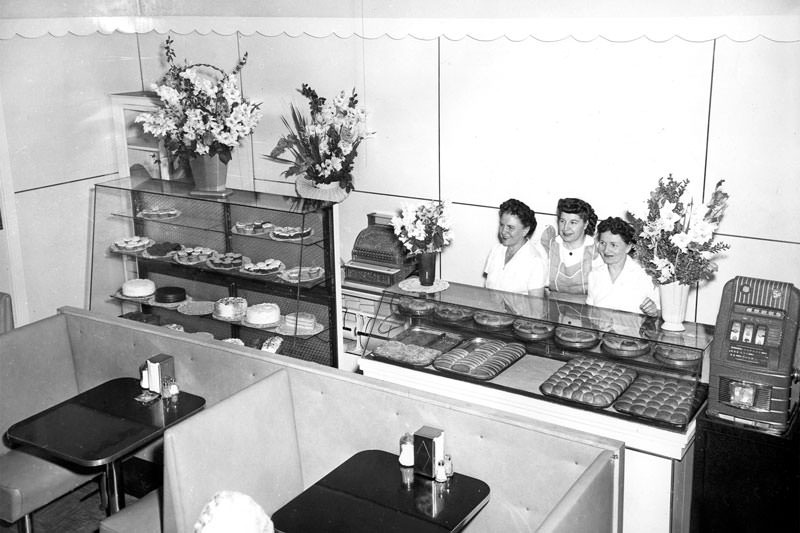Forty years with the Dainty Cake Shoppe.
Maybe the only thing Americans like more than a good success story is a good slice of homemade cake. For four decades, Reno had them both, in a downtown bakery called Dainty Cake Shoppe, run by two Italian-American sisters, Virginia Pizorno and Mary Romano.
A Tale of Two Sisters
Virginia and Mary Patrone grew up in Verdi and always were close, even marrying in a double ceremony in 1914 and living only one block apart from each other after marriage. Their story is part of a 150-year presence of Italian-Americans in Northern Nevada, forming a close-knit community by the mid-20th century.
The story picks up in 1928 when the sisters started Dainty Cake Shoppe (also sometimes written as “Shop”) in Downtown Reno. This famous bakery was open for 40 years and served three generations of Renoites. The sisters made their mark in some other ways, too. As grandson Larry Pizorno describes in the Italian American Oral History Project, they were “some of the first women of the Italians to break away and start their own businesses…[Virginia] was one of the first, almost one of the founders, of the Reno Professional Businesswomen’s Organization here.”
The bakery originally was on First Street and moved to 237 Sierra St. at Second Street in 1945. At this location, the women expanded with a lunch counter, run by Virginia’s son, Roy. According to an ad from 1943, it offered “the most delightful breakfast in town.” Larry recounts that in 1963, Del Webb bought the block, eventually building the Sahara Hotel and Casino there. The sisters decided it was too expensive — and they were getting too old — to move the business, and they wanted to retire. In 1965, they shut Dainty Cakes’ doors for the last time.
The Place for Cakes
Dainty Cake Shoppe was at the sweet center of all occasions in Reno. It gained fame for its Lady Baltimore, a white layer cake with fluffy frosting and a fruit-and-nut filling. Everything was baked from scratch. As Larry says, “Butter they used was real butter they got from local dairies. Eggs were from real chickens. And yeasts, sugars, and honeys, and all that stuff were all real. Everybody shopped there. Everybody in town.”
The demand for Dainty’s special occasion cakes was so great that its ovens could bake 12 three-layer cakes at one time. The women made cookies, cupcakes, and cinnamon rolls and still had energy to crank out 100 dozen rolls each day. They became known for fruitcake during the holidays, as a Nevada State Journal article in 1938 mentions: “Once upon a time it was an arduous home kitchen job … now you can get the kind mother used to make by phoning 4392 and giving your holiday order, the same place where you get your delicious mince and pumpkin pies, and your better than homemade layer cakes — the Dainty Cake Shoppe.”
Two Challenges
Success didn’t come without obstacles. The nearest the bakery came to a crisis was with the sugar scarcity during World War II. As business increased, sugar supply dwindled when rationing began. Bakeries were typically allotted 70 percent of their normal usage. The sisters were 7,500 pounds over their sugar quota and reduced to using honey, Karo syrup, and anything sweet they could find to make their confections. At one point, they located a bakery in Carson City in need of shortening and traded some for sugar.
By 1950, a different challenge faced the bakery. The Culinary Workers Union #45 stationed picketers in front of the store, in a continuing campaign to organize fountain employees. Roy said he would resist the organizing of his three fountain employees “to the last ditch. I’m going to stick a sign in this window calling this place ‘Freedom’s Last Frontier’ and keep right on fighting.” He claimed none of the employees wanted union membership and the bakery paid above union scale wages — $36 per six-day week, plus three meals a day and tips.
The two women were asked, at their retirement, about the secret to running a successful bakery business. As reported in the Nevada State Journal in 1965, their answer was simple: “Work.” After 40 years of going downtown every day at 4:30 a.m., the sisters retired to their gardens. Apparently, nothing could sweeten the deal to work from home. They vowed, “When we leave here, there’ll be no more baking.”
Sharon Honig-Bear was the long-time restaurant writer for the Reno Gazette-Journal. She relishes Reno history and is a tour leader with Historic Reno Preservation Society. You can reach her with comments and story suggestions at Sharonbear@sbcglobal.net.


